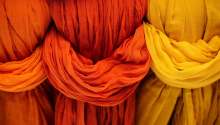What is sustainable clothing?
The clothing sector has huge environmental impacts worldwide. Accounting for around 8% of all global emissions, it is also responsible for widespread pollution and waste.
Sustainable clothing aims to tackle these issues by using fabrics and processes that are lower-carbon, less polluting and address other environmental harms.
In recent decades, fast fashion brands like Boohoo and Pretty Little Thing have boomed. They have mainstreamed a model of clothing that is low-cost, poor-quality and has a short shelf life.
Sustainable clothing offers an antidote to this – slowing the cycle down and providing items that are designed to last.
Truly sustainable fashion brands will also take a holistic approach, addressing workers’ rights in the clothing industry and animal rights issues, as well as environmental concerns.
How to spot fashion brands that are sustainable
Clothing brands that are really sustainable should provide plenty of information about steps that they are taking to cut their emissions, tackle their environmental impacts, and ensure workers’ rights in their supply chains.
These are likely to include:
Using more sustainable fabrics
The most sustainable fabrics are recycled, reusing fibres that are already in the clothing loop, rather than needing a constant new supply. Recycling substantially cuts emissions and waste. Also look out for certified options like organic and Fairtrade.
Selling secondhand
Preloved clothing is without doubt the most ethical and sustainable option. Look out for dedicated secondhand brands, and ethical clothing shops with a secondhand range.
Our ethical clothing guide rates eight secondhand retailers.
Publishing lists of suppliers
Brands generally do not own the factories where their clothes are made. It is vital that consumers, environmental advocacy groups, and workers’ rights organisations know where clothes are made, so they can alert companies to problems and hold brands to account.
The best companies will be publishing all the factories in their supply chains.
Cutting emissions throughout their supply chains
The majority of emissions for clothing companies arise during manufacturing.
While lots of companies will advertise the fact they are adding solar panels to their office roof or using less paper, meaningful changes need to take place in the factories they use.
Look for companies saying they are working with suppliers to cut emissions.
Outlining ways that they are ensuring workers’ rights
The fashion industry is notorious for workers’ rights abuses.
Truly sustainable brands will be taking clear steps to respect those in their supply chains – and publishing plenty of information about them. For example, they might select a small number of manufacturers, with whom they build a long-term relationship. They might use certifications that include workers’ right requirements, such as Fairtrade.
Offering repairs and ‘take back’ schemes
Clothing is often thrown away because we’re unsure how to repair it when it's torn or needs altering.
Some companies are now offering special repair services, meaning that you can keep your items for longer – and substantially cut your wardrobe’s carbon footprint in the process.
Other brands will take your unwanted clothes in order to recycle the fibres into new.
In general, look for a brand that is built around ethics and sustainability – rather than a mainstream fashion brand that is making a small number of sustainability claims.







